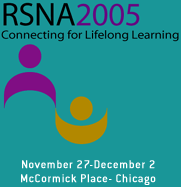
Abstract Archives of the RSNA, 2005
SST13-05
Contrast-enhanced MR Cholangiography Using Mangafodipir Trisodium: Exclusion Criteria of Biliary Atresia
Scientific Papers
Presented on December 2, 2005
Presented as part of SST13: Pediatric (Gastrointestinal)
Hun-Kyu Ryeom MD, Abstract Co-Author: Nothing to Disclose
Jae-Hyuk Lee, Presenter: Nothing to Disclose
Byung-Ho Choi, Abstract Co-Author: Nothing to Disclose
Contrast-enhanced magnetic resonance cholangiography (CEMRC) with Mangafodipir trisodium (Mn-DPDP) is a newly developed method for excluding biliary atresia (BA). The aim of this study is to determine the exclusion criteria of BA by CEMRC using Mn-DPDP.
Thirty-six jaundiced infants with suspected BA by ultrasonography were prospectively evaluated using CEMRC and magnetic resonance cholangiopancreatography (MRCP) 1-5 days prior to 99mTc-DISIDA. The diagnostic criteria for excluding BA were as follows: 1) Conventional MRCP, unequivocal visualization of the extrahepatic bile duct; 2) DISIDA scan, visualization of intestinal radioactivity; 3) CEMRC criterion-1, bowel excretion of contrast material; 4) CEMRC criterion-2, bowel excretion and/or extrahepatic biliary tree filling. For ultrasonography, triangular cord of 4 mm or more in thickness. The final diagnosis was made by operation in eight BA patients and clinical follow-up and laboratory findings in 33 non-BA patients. The diagnostic accuracy of CEMRC by each criterion was compared with that of conventional MRCP, a 99mTc-DISIDA scan, and ultrasonography.
Diagnostic accuracy of CEMRC for excluding BA was 100% and 95% by criterion-1 and criterion-2, respectively. Those of ultrasonography, 99mTc-DISIDA scan were 85% and 74.3%, respectively. The false positive rate of CEMRC by criterion-1 and criterion-2 were 6.3% and 0%, respectively. Those of ultrasonography and 99mTc-DISIDA scan were 6.2% and 32.1%, respectively.
These results suggest that CEMRC using Mn-DPDP is more accurate than MRCP, 99mTc-DISIDA scans, or ultrasonography for the early exclusion of BA. As such, CEMRC using Mn-DPDP would appear to be a promising modality in the early exclusion of BA as the cause of neonatal cholestasis.
Ryeom, H,
Lee, J,
Choi, B,
Contrast-enhanced MR Cholangiography Using Mangafodipir Trisodium: Exclusion Criteria of Biliary Atresia. Radiological Society of North America 2005 Scientific Assembly and Annual Meeting, November 27 - December 2, 2005 ,Chicago IL.
http://archive.rsna.org/2005/4420060.html

